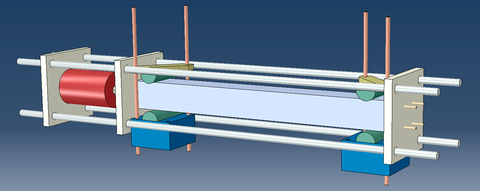Impact on structures subjected to normal force
Table of contents
Project data
| Titel | Title Promotionsprojekt A6/III: Verstärkung normalkraftbeanspruchter Strukturen gegen eine Stoßbelastung quer zur Bauteilachse als Teilprojekt des GRK 2250 | Doctoral project A6/III: Strengthening of structures subjected to normal forces against an impact load transverse to the normal force as part of the RTG 2250 Förderer | Funding Deutsche Forschungsgemeinschaft (DFG) / GRK 2250 Zeitraum | Period 05/2023 – 04/2026 (3. Kohorte | 3rd cohort) |
Report in the year book 2023
Transverse impact on concrete columns

Principle of an axial load application setup for a column to be tested under impact
The doctoral project A6/III is part of the third cohort of the RTG 2250 program, in which one post-doctoral and twelve doctoral candidates working together in different institutes of TU Dresden and at IPF Dresden synergically. RTG 2250 is a Research Training Group that focuses on developing innovative mineral-bonded composite-based strengthening methods for structures subjected to impact loading. The goal of the A6/III project is to experimentally evaluate the structural behavior of axially loaded reinforced concrete members under impact loading. Investigating axially loaded structures is important as there are various real-life examples of severe column or wall damage after a vehicle collision or rock fall.
The first steps of this project include studying the previous combinations of impact and axial load test setups used by other researchers and choosing an appropriate one to use in the drop tower located at the Otto Mohr Laboratory. There are some limitations regarding the dimension of the specimen and the high-speed camera view on the specimen in the drop tower, therefore we decided to use a hydraulic jack (which needs less space compared to other methods like external rebars and a mass or using disc springs in addition to the hydraulic jack) for axial load application. The next step is to select suitable materials for strengthening axially-loaded concrete members (such as textile-reinforced concrete, strain-hardening cementitious composite (SHCC), and damping materials) and to test specimens with and without layers of these strengthening materials under different impact energies to provide the best strengthening method that has appropriate strengthening and energy-absorbing properties. Finally, the results will be evaluated and an engineering model will be presented for such concrete members under impact loading.
The Reserach Training Group 2250 is not only about science but also an opportunity to develop our soft skills as well as hard skills. Participating in annual summer schools and winter workshops in which we need to present our current research state and find probable collaborations in the team is a good example of the combination of hard and soft skills development.
